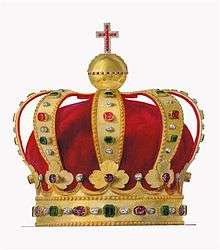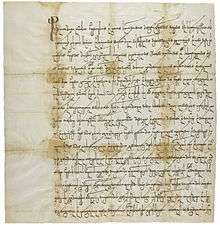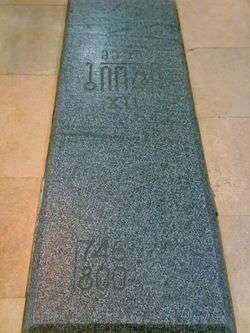George XII of Georgia
George XII (Georgian: გიორგი XII, Giorgi XII), sometimes known as George XIII (November 10, 1746 – December 28, 1800), of the House of Bagrationi, was the second and last King of the Kingdom of Kartli and Kakheti (eastern Georgia) from 1798 until his death in 1800. His brief reign in the closing years of the 18th century was marked by significant political instability, which implied the near certainty of a civil strife and a Persian invasion. Weakened by poor health and overwhelmed by problems in his realm, George renewed a request of protection from Tsar Paul I of Russia. After his death, Imperial Russia took advantage of the moment and moved to annex the Georgian kingdoms, while sending the remnants of the Georgian royal family into forced exile in Russia.
| George XII | |
|---|---|
 | |
| King of Kartli and Kakheti (more...) | |
| Reign | 12 January 1798 – 28 December 1800 |
| Coronation | 5 December 1799 (Anchiskhati) |
| Predecessor | Heraclius II |
| Born | 10 November 1746 Telavi |
| Died | 28 December 1800 (aged 54) Tbilisi |
| Burial | |
| Consort | Ketevan Andronikashvili Mariam Tsitsishvili |
| Issue among others... | David |
| Dynasty | Bagrationi |
| Father | Heraclius II |
| Mother | Anna Abashidze |
| Religion | Georgian Orthodox Church |
| Khelrtva |  |
Early life and accession to the throne
George was born to Heraclius II (Erekle), then the king of Kakheti, and later also of Kartli, and his second wife Anna Abashidze. George was recognized in about 1766 by his father as Crown Prince Batonishvili, and appointed the lord of Pambak and Lori (now in Armenia). In 1770, he took part in Heraclius’ militarily successful, but ultimately fruitless expedition against the Ottoman garrisons in southern Georgia. In 1777, George, together with his half-brother, Prince Levan, campaigned against the defiant eristavi ("duke") of the Ksani and subdued his domain to the royal crown.
George ascended the Georgian throne upon his father's death on January 12, 1798, being recognized by Tsar Paul on February 22, 1799 and crowned at the Anchiskhati Church in Tiflis on December 5, 1799. His capital, Tiflis, still lay largely in ruins and the country was suffering after-effects of the Persian invasion of 1795 which was a response to Heraclius' rapprochement with Imperial Russia (The Treaty of Georgievsk of 1783) and his refusal to submit to the Persian authority.
Troubles in Georgia

The three years of his reign was a time of confusion and instability. Unlike his heroic father, George did not enjoy popularity among his subjects and few had any respect for him. Suffering from excess of corpulence and edema, the king mostly lay ill in Tiflis and remained fanatically devout. He was beset by the intrigues of his stepmother, the Dowager Queen Darejan (Darya), who sought to deprive George's offspring of the throne in favor one of her own sons. His numerous half-brothers ensconced on the large domains assigned to them by their late father and ignored his authority. One of them, Alexander, left for Dagestan and remained in armed opposition to the king and his pro-Russian policies for years.
To make things even worse, Fath Ali Shah of Persia demanded that George XII send his oldest son to Tehran as a hostage and commanded to submit his country to the Persian vassalage. Immediately after George's ascension to the throne, the shah wrote to the Georgian monarch:
"Our lofty standard will proceed to your lands and, just as occurred in the time of Agha Mohammed Khan, so now you will be subjected to doubly increased devastation, and Georgia will again be annihilated, and the Georgian people given over to our wrath."[1]
Thus, living in constant fear of being deposed, or of seeing yet another Persian army invading his kingdom, George was forced to the conclusion that something more than a formal Russian protectorate was needed to ensure the kingdom's survival. By that time, many leading Georgian politicians were disillusioned in the alliance with Russia since the latter had failed to provide any support during the 1795 Persian attack. Furthermore, George's illness aroused an issue of the king's possible successor and divided the Georgian nobles into rival parties; one of them seconded the crown prince David, son of George XII, and the other proffered the king's half-brother Iulon.
Alliance with Russia

In order to secure succession to his son, and prevent the kingdom from being dragged into a civil war, George had already sent, in September 1799, an embassy to St Petersburg with instructions to negotiate a new treaty with Tsar Paul I of Russia. This time, the imperial government showed more interest towards Georgia as Napoleon's Egyptian campaign drew Paul’s attention to the Middle East. In November 1799, a small Russian force arrived in Tiflis and Peter Ivanovich Kovalensky, the Tsar’s envoy, assumed control of Georgia’s foreign relations. Kovalensky and Hājjī Ebrāhīm Shīrāzī, the Persian minister, exchanged fiery notes reaffirming their governments’ determination to keep Georgia under their vassalage and threatening to enforce their interests by force.[1]
The interrupted negotiations between Russia and Georgia were resumed, but gradually shifted focus. King George offered the Tsar more authority over internal and foreign affairs of Georgia provided that the right of his dynasty to rule the country and the autocephaly of the Georgian Orthodox Church would be guaranteed. However, while the Georgian envoys were in St Petersburg still negotiating the terms of the new treaty, Paul I decided to annex the kingdom outright and, in November 1800, wrote to the Russian commander in Tiflis: "The weakening of the king’s health gives ground for expecting his decease; you are therefore immediately to dispatch, as soon as this occurs, a proclamation in Our name that until Our consent is received no action should be taken even to nominate an heir to the Georgian throne."[2] On December 18, 1800, the Tsar signed a manifesto unilaterally annexing the Georgian realm to the Russian crown. Neither Paul nor George were fated to see the manifesto published, however. On 28 December 1800, before his emissaries had returned from St. Petersburg, George XII died and his son, David, declared himself a regent of Georgia. Paul himself was murdered on March 11, 1801, and his successor, Alexander I refused to allow David to be crowned a king and formally reaffirmed the annexation in the September 12, 1801 decree.
Marriages and children

George was married twice:
Firstly in 1766 to Princess Ketevan Andronikashvili (1754 – 23 April 1782), allegedly from a cadet branch of the Komnenoi family. They had 12 children:
- David (1 July 1767 – 25 May 1819).
- Ioan (16 May 1768 – 15 February 1830).
- Varvara (1769 – 1801), married Prince Svimon Andronikashvili
- Sophio (1770 – 28 September 1840), married Prince Luarsab Tarhan-Mouravi.
- Luarsab (1771 – bef. 1798).
- Nino (15 April 1772 – 30 May 1847), married Prince Grigol I of Mingrelia.
- Salome (c. 1773 – 3 January 1777), married Prince Alexander of Imereti.[3]
- Bagrat (8 May 1776 – 8 May 1841).
- Rhipsime (c. 1779 – 27 May 1847), married Prince Demetre Cholokashvili.
- Gayana (27 September 1780 – 22 July 1820), married Prince Giorgi Eristavi of Ksani.
- Solomon (c. 1781 – bef. 1798).
- Teimuraz (23 April 1782 – 25 October 1846).
Secondly on 13 July 1783 to Princess Mariam Tsitsishvili (9 April 1768 – 30 March 1850). They had 11 children:
- Mikheil (1783 – 21 November 1862)
- Jibrael (13 August 1788 – 29 February 1812), twin with Tamar.
- Thamar (13 August 1788 – 29 July 1850), twin with Jibrael.
- Ana (1789 – 1796).
- Ilia (2 September 1790 – 18 July 1854).
- Ioseb (c. 1792 – bef. 1798).
- Spiridon (c. 1794 – bef. 1798).
- Okropir (24 June 1795 – 30 November 1857).
- Svimeon (1796 – died in infancy).
- Irakli (1799 – 20 October 1859).
- Ana (1800 – 26 May 1850), married firstly Prince Estate Abashidze and secondly Prince David Tsereteli.
Ancestry
| Ancestors of George XII of Georgia | |||||||||||||||||||||||||||||||||||||||||||||||||||||||||||||||||||||||||||||||||||||||||||||||||||||||||||||||||||||||||||||||||||||||||||||||||||||||||||||||||||||||||||||||||||||||||||||||||||||||||||||||||||||||||||||||||||||||||||||||||||||||||||||||||||||||||||||||||||||||||||||||||||||||||||||||||||||||||||||||||||||||||||||||||||||||||||||||||||||||||||||||||||||||||||||||||||||||||||||||||||||||||||||||||||||||||||||||||||||||||||||||||||||||||||||||||||
|---|---|---|---|---|---|---|---|---|---|---|---|---|---|---|---|---|---|---|---|---|---|---|---|---|---|---|---|---|---|---|---|---|---|---|---|---|---|---|---|---|---|---|---|---|---|---|---|---|---|---|---|---|---|---|---|---|---|---|---|---|---|---|---|---|---|---|---|---|---|---|---|---|---|---|---|---|---|---|---|---|---|---|---|---|---|---|---|---|---|---|---|---|---|---|---|---|---|---|---|---|---|---|---|---|---|---|---|---|---|---|---|---|---|---|---|---|---|---|---|---|---|---|---|---|---|---|---|---|---|---|---|---|---|---|---|---|---|---|---|---|---|---|---|---|---|---|---|---|---|---|---|---|---|---|---|---|---|---|---|---|---|---|---|---|---|---|---|---|---|---|---|---|---|---|---|---|---|---|---|---|---|---|---|---|---|---|---|---|---|---|---|---|---|---|---|---|---|---|---|---|---|---|---|---|---|---|---|---|---|---|---|---|---|---|---|---|---|---|---|---|---|---|---|---|---|---|---|---|---|---|---|---|---|---|---|---|---|---|---|---|---|---|---|---|---|---|---|---|---|---|---|---|---|---|---|---|---|---|---|---|---|---|---|---|---|---|---|---|---|---|---|---|---|---|---|---|---|---|---|---|---|---|---|---|---|---|---|---|---|---|---|---|---|---|---|---|---|---|---|---|---|---|---|---|---|---|---|---|---|---|---|---|---|---|---|---|---|---|---|---|---|---|---|---|---|---|---|---|---|---|---|---|---|---|---|---|---|---|---|---|---|---|---|---|---|---|---|---|---|---|---|---|---|---|---|---|---|---|---|---|---|---|---|---|---|---|---|---|---|---|---|---|---|---|---|---|---|---|---|---|---|---|---|---|---|---|---|---|---|---|---|---|---|---|---|---|---|---|---|---|---|---|---|---|---|---|---|---|---|---|---|---|---|---|---|---|---|---|---|---|---|---|---|---|---|---|---|---|---|---|---|---|---|---|---|---|---|---|---|---|---|---|---|---|---|---|---|---|---|---|---|---|---|---|---|---|---|---|---|---|---|---|---|---|---|---|---|
| |||||||||||||||||||||||||||||||||||||||||||||||||||||||||||||||||||||||||||||||||||||||||||||||||||||||||||||||||||||||||||||||||||||||||||||||||||||||||||||||||||||||||||||||||||||||||||||||||||||||||||||||||||||||||||||||||||||||||||||||||||||||||||||||||||||||||||||||||||||||||||||||||||||||||||||||||||||||||||||||||||||||||||||||||||||||||||||||||||||||||||||||||||||||||||||||||||||||||||||||||||||||||||||||||||||||||||||||||||||||||||||||||||||||||||||||||||
Notes
- Fisher, page 330.
- Lang, page 39.
- (in Russian) Grebelsky, P. Kh., Dumin, S. V., Lapin, V. V. (1993), Дворянские роды Российской империи (Noble families of Russian Empire), vol. 3, p. 90. IPK Vesti.
References
| Wikimedia Commons has media related to George XII of Georgia. |
- Lang, D. M., The Last Years of the Georgian Monarchy, 1658-1832. New York, 1957, 253-270, 283-284.
- Lang, David Marshall, A Modern History of Georgia. London: Weidenfeld and Nicolson, 1962.
- Rhinelander, L. H. The Incorporation of the Caucasus into the Russian Empire. The Case of Georgia 1801-1854. New York, 1972.
- Fisher, William Bayne, The Cambridge History of Iran. Cambridge University Press, 1991.
| Regnal titles | ||
|---|---|---|
| Preceded by Heraclius II |
King of Georgia 1798–1800 |
Succeeded by Paul I of Russia as Tsar |
| Succeeded by David Bagrationi as Regent | ||
| Monarchy abolished Georgia annexed by Imperial Russia | ||